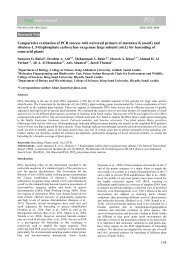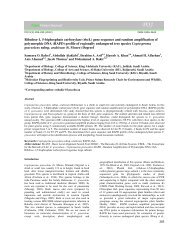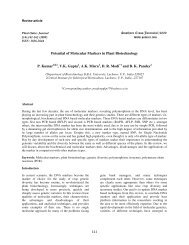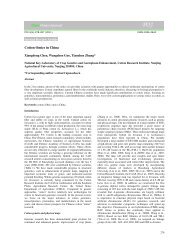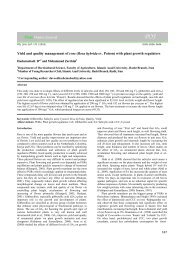Create successful ePaper yourself
Turn your PDF publications into a flip-book with our unique Google optimized e-Paper software.
Mini Review<br />
<strong>Plant</strong> <strong>Omics</strong> Journal<br />
Southern Cross Journals©2009<br />
2(2):78-84 (2009) www. pom i cs. com<br />
ISSN: 1836-3644<br />
The effect of low temperature on metabolism of membrane lipids in plants and associated<br />
gene expression<br />
Cosmin Badea 1 and Saikat Kumar Basu 2*<br />
1 Department of Agriculture, Food & Nutritional Sciences - <strong>Plant</strong> Science, University of Alberta, Edmonton, AB,<br />
Canada T6G 2R3<br />
2 Department of Biological Sciences, University of Lethbridge, Lethbridge AB, Canada T1K 3M4<br />
* corresponding author:saikat.basu@uleth.ca<br />
Abstract<br />
Lipid metabolism plays an important role in the mechanism of frost or cold-tolerance in plants. <strong>Plant</strong> membrane<br />
lipids have the tendency to change from gel to liquid-crystalline phase in response to low temperature stress. This<br />
process is due to the increased level of lipid desaturation. The responsible components of this process are, among<br />
others, the fatty acid desaturases. Controlling the activity of these enzymes affects the amount of polyunsaturated<br />
fatty acids on the glycerol backbone and eventually controls the plants sensitivity to low temperature stress. These<br />
metabolic processes trigger a series of changes at the transcriptional level, causing differential expression in genes.<br />
Numerous approaches towards this process from chemical to the advanced mass spectrometry were taken during the<br />
past decades and several of them will be discussed in this minireview. Metabolomics and transcriptomics seem to be<br />
the keys towards describing these complex mechanisms and providing the necessary understanding of lipid<br />
metabolic response to low temperature stress.<br />
Keywords: Lipid metabolism; desaturase enzymes; desaturation; gene expression.<br />
Abbreviations: ABA_abscisic acid; DAG_diacylglycerol; DBI_double bond index; DGDG_digalactosyldiacylglycerol;<br />
EL_electrolyte leakage; ER_endoplastic reticulum; FS_free sterols; GL_glycolipids; MDA_malonic<br />
dialdehyde; MGDG_monogalactosyldiacylglycerol; PA_phosphatidic acid; PC_phosphatidylcholine; PE_phosphatidylethanolamine;<br />
PI_phosphatidylinositol; PL_phospholipids; pr_lipids/proteins ratios; ROS_ reactive oxygen<br />
species; VLCPUFA_very long chain polyunsaturated acids<br />
Introduction<br />
When exposed to different stresses, plants have<br />
different ways of dealing with it to compensate for<br />
their lack of mobility. Cold is an abiotic stress that<br />
has been intensively studied in plants because of its<br />
negative effects on plant growth and development<br />
which is related to yield and productivity rates in<br />
cultivated crops. This is a limiting factor for growing<br />
plants from warmer areas in different climatic areas<br />
where the temperature is less suitable for cultivation.<br />
The plants response to cold varies from species to<br />
species and even within the same plant family.<br />
However, regardless of plant species complexity, one<br />
major common mechanism used by plants to deal<br />
with cold stress is changes in membrane lipid<br />
composition to protect its membrane stability and<br />
integrity. It was reported that there is also a great<br />
accumulation of soluble sugars in response to cold<br />
stress (Deryabin et al. 2005) and even the major role<br />
78
Mini Review<br />
that is played by light in this complex response<br />
mechanism (Zhu et al. 2007). These metabolic<br />
processes trigger a series of changes at the<br />
transcriptional level, determining differential<br />
expression in genes. It is believed that deciphering the<br />
mechanism of membrane lipids of plants exposed to<br />
low temperature will help in finding the answer to<br />
cold stress that could be a major breakthrough for the<br />
future of agriculture.<br />
This mini review highlights the efforts of several<br />
groups in studying the membrane lipids changes<br />
during cold acclimatization and its effect on the gene<br />
expression in different plant species, such as Adzuki<br />
beans (Vigna angularis (Wild.) Ohwi & Ohashi),<br />
Arabidopsis (Arabidopsis thaliana (L.) Heynh.),<br />
chickpea (Cicer arietinum L.), coffee bean (Coffea<br />
sp.), cucumber (Cucumis sativus L.), figleaf gourd<br />
(Cucurbita ficifolia Bouché), potato (Solanum<br />
tuberosum L.), rapeseed (Brassica napus L.), rice<br />
(Oryza sativa L.), soybean (Glycine max (L.) Merr.),<br />
and winter wheat (Triticum aestivum L.) (Table 1).<br />
The results and conclusions and the correlations<br />
among these variety of plants are discussed and<br />
compared in order to give a broader picture of the<br />
mechanism of membrane lipids metabolism.<br />
However, despite the fact that the approaches taken<br />
and the plant material were differed among the<br />
research groups in the end their results were,<br />
surprisingly, quite alike.<br />
Changes in plants in response to low temperature<br />
stress<br />
It is known to a great extent that one of membrane<br />
lipids response action when exposed to cold would be<br />
the increase in the unsaturation of fatty acids<br />
compared to fatty acids in plant under normal<br />
conditions (Tasseva et al. 2004; De Palma et al.<br />
2008). However, this ratio differs substantially from<br />
plant to plant and even the same plant can act<br />
differently depending on the way of exposure to low<br />
temperature (i.e. acclimated (3-4°C) vs. nonacclimated<br />
plants (22-24°C)). Most of the research<br />
focused on the impact of cold on leaves and roots.<br />
Rapeseed<br />
Tasseva et al. (2004) have studied the lipid changes in<br />
response to cold in the endoplasmic reticulum (ER) of<br />
rapeseed. They observed an increase in the level of<br />
unsaturation when the plants were grown at 4°C.<br />
Choosing the ER for their analysis they were hoping<br />
that would provide more insight on the lipid<br />
metabolism, knowing that ER is the site for lipid<br />
biosynthesis. They have studied the action of the<br />
desaturases and acyltransferases after cold stress. For<br />
the experiment they studied frost-tolerant and -<br />
sensitive cultivars, respectively. They used the double<br />
bond index (DBI) to measure the unsaturation levels<br />
of the lipids for analyzing their results. There were<br />
not major differences in lipid changes between the<br />
two cultivars with the exception of the increase (3%)<br />
in the very long chain polyunsaturated acids<br />
(VLCPUFA) in the sensitive plants at 4°C. Overall,<br />
there was an important increase in linoleic (18:2) and<br />
alpha-linolenic (18:3) acids in both types of studied<br />
plants when exposed to low temperature. However,<br />
what is notable is the time of accumulation of these<br />
acids in the tested plants. The tolerant plants showed<br />
a very fast accumulation in unsaturated acids, after<br />
only a few days compared to the sensitive ones,<br />
conferring a more rapid adaptation to cold. This could<br />
lead to the conclusion that the tolerant plants have a<br />
better responding mechanism to reduce cold stress<br />
membrane damages. To better understand this<br />
process, Tasseva et al. (2004) performed analysis at<br />
the transcriptional level, too. In this way they found<br />
that there were changes in the transcript level of<br />
certain enzymes involved in lipid metabolism. There<br />
was a substantial increase in stearoyl-ACP desaturase<br />
isogene level that was orthologous to At1g43800<br />
gene. All the other enzymes did not show major<br />
difference in transcript level when compared to<br />
results from the sensitive plants. They concluded that<br />
this desaturase played a major role in the coldtolerance<br />
mechanism of membrane lipids.<br />
Potato<br />
The implication of the stearoyl-ACP desaturase has<br />
also been, recently, studied by De Palma et al. (2008)<br />
and the implication of this desaturase gene in<br />
changing the composition of the membrane lipids in<br />
potato plants. Their work suggests that the expression<br />
of the stearoyl-ACP desaturase (w-9) gene in plants<br />
will increase the cold tolerance in plants due to the<br />
increased desaturation of the fatty acids and thus a<br />
better membrane control of damage at the membrane<br />
level. They have compared transgenic plants carrying<br />
w-9 gene and non-transgenic plants that were either<br />
cold-acclimated or non-acclimated. They found that<br />
plants with increased cold tolerance showed a<br />
substantial increase in linoleic acid (18:2) compared<br />
to the more sensitive plants that presented an<br />
79
Mini Review<br />
increased in alpha-linolenic acid (18:3). They<br />
suggested that the major component of this<br />
mechanism was the level of desaturases in the plants.<br />
However, upon fatty acid analysis of the plants they<br />
observed that the extrachloroplastic membranes of the<br />
transgenic plants contained, among the normal fatty<br />
acids, a cis-vaccenic acid (18:1 ∆ 11) in<br />
phosphatidylcholine (PC) and phophatidylethanolamine<br />
(PE) which is unusual in plants (3%). They<br />
believe that the presence of this peculiar fatty acid is<br />
due to the excess of the stearoyl-ACP desaturase as<br />
previously stated by Tasseva et al. (2004). Overall,<br />
the membrane lipids upon stress have changed their<br />
composition showing increase (by 5 to 10%) in<br />
unsaturated fatty acids in potato.<br />
Potato plants were also used as a material to study<br />
cold stress and changes in membrane lipids. Deryabin<br />
et al. (2005) used transgenic plants that contained a<br />
yeast-derived invertase gene (B33-inv plants) to study<br />
peroxidation of membrane lipids exposed to low<br />
temperatures. Invertases are enzymes that are<br />
involved in sugar metabolism that catalyses the<br />
hydrolysis of sucrose into glucose and fructose. They<br />
focused on the importance of soluble sugar in lipid<br />
peroxidation due to low temperature exposure. Lipid<br />
peroxidation has been measured as the accumulation<br />
of its secondary product malonic dialdehyde (MDA)<br />
in potato leaves. Analyzing the plants after chilling<br />
(3°C) they have found that there is a slight increase in<br />
MDA in both B33-inv plants (tolerant) and nontransgenic<br />
(sensitive) plants with a higher content<br />
(17%) in the sensitive plant. However, after<br />
decreasing the temperature (-1°C) they observed an<br />
even higher increase (62%) for the sensitive<br />
compared to tolerant plants. They have concluded<br />
that this low increase in MDA for the transgenic<br />
plants is due to the invertase gene and that it plays an<br />
important role in tolerance to low temperatures. Their<br />
work did not provide any information on lipids<br />
classes’ changes in detail but it gives important<br />
information on other factors, such as sugar<br />
interaction, involved in membrane lipid behavior<br />
when exposed to cold stress.<br />
Winter Wheat<br />
Bohn et al. (2007) studied the effect of cold on the<br />
plasma membrane lipids of winter wheat. It is known<br />
that the recovery of the plant after exposure to low<br />
temperature during winter is critical for its<br />
productivity. Their work focused on two different<br />
methods to induce cold, either by exposure to low<br />
temperature or by treatment with the hormone<br />
abscisic acid (ABA) on both cold- and non<br />
acclimated plants. The plant material chosen for<br />
testing had different levels of cold tolerance. Three<br />
major lipid groups were taken into consideration,<br />
such as free sterols (FS), glycolipids (GL) and<br />
phospholipids (PL) when applying cold treatment.<br />
Changes in these groups were observed during the<br />
experiment. In their study, they measured changes in<br />
lipids/proteins (pr) ratios between plants (stressed vs.<br />
non-stressed, cold- vs. non-acclimated and cold<br />
induced vs. ABA induced stress). The results are<br />
quite different and showed that the stress response<br />
mechanism is very complex. Moreover, they have<br />
found that the way of inducing the stress plays an<br />
important role in the plant response.<br />
Without taking into consideration their differences<br />
in percentage of lipids between cold-tolerant and -<br />
sensitive plants, the only major difference in<br />
lipid/protein ratios was that of GL/pr for the tolerant<br />
plants. However, plants from etiolated seedlings<br />
stressed by ABA presented different protein ratios for<br />
almost all lipid classes, FS, PL, GL, TL, while only<br />
classes for GL were identified by tolerant plants<br />
derived from green seedlings. These are very<br />
important findings for biotechnology, knowing that<br />
hormone manipulation is considered one of the many<br />
options in genetic engineering. Regardless of the<br />
stress-inducing method, there have been notable<br />
changes in membrane lipids upon stress. The amount<br />
of free sterols increased in all plants, as well as the<br />
phospholipids, with the exception of the susceptible<br />
plants. Glycolipid amount showed a decrease for all<br />
tested plants. The amount of alpha-linolenic acid<br />
(18:3) doubled for the resistant plant in PC and PE.<br />
However, the amount of linoleic acid (18:2) increased<br />
in PL for the same plants. This confirms the findings<br />
of De Palma et al. (2008) on potato tolerant plants.<br />
Analogous experiments with similar results involving<br />
the role of ABA on the desaturation of fatty acids<br />
were performed by Bakht et al. (2006) on chickpea.<br />
Rice<br />
Rice is another species that has been studied for low<br />
temperature stress and its influence on membrane<br />
lipids. Zhu et al. (2007) have studied the unsaturated<br />
levels of fatty acids in lipids of the chloroplastic<br />
thylakoid membrane. After studying three rice<br />
cultivars with different levels of resistance they<br />
observed positive correlations between the<br />
unsaturated fatty acids (18:1, 18:2 and 18:3) and the<br />
80
Mini Review<br />
Table 1. The diversity of cold tolerance on of lipid membrane metabolism in different plant species<br />
<strong>Plant</strong> species Scientific names <strong>Plant</strong> families Genes reported <strong>Plant</strong> part or cell organelle<br />
targeted<br />
References<br />
Rapeseed Brassica napus Brassicaceae (D) w-9 Endoplasmic reticulum Tasseva et al. (2004)<br />
Potato Solanum tuberosum Solanaceae (D)<br />
w-9 Stems De Palma et al. (2008)<br />
B33-inv Leaves Deryabin et al. (2005)<br />
Winter wheat Triticum aestivum Poaceae (M) C-repeat binding factors,<br />
Seedlings Bohn et al. (2007)<br />
dehydration responsive elements,<br />
abscisic acid responsive elements<br />
Rice Oryza sativa Poaceae (M) - Chloroplastic thylakoid membrane Zhu et al. (2007)<br />
Adzuki beans Vigna angularis Fabaceae (D) - Root cell suspension culture Kojima at al. (1998)<br />
Coffee Coffea sp. Rubiaceae (D) - Whole plants Campos et al. (2003)<br />
Soybeans Glycine max Fabaceae (D) - Thylakoid from leaves Tambussi et al. (2004)<br />
Cucumber Cucumis sativus Cucurbitaceae (D) - Roots Lee et al. (2005)<br />
Figleaf gourd Cucurbita ficifolia Cucurbitaceae (D) - Roots Lee et al. (2005)<br />
Arabidopsis Arabidopsis thaliana Brassicaceae (D) PLDα1 <strong>Plant</strong> tissues (specific part not<br />
reported)<br />
(M) = Monocotyledonous; (D) = Dicotyledonous<br />
Wang et al. (2006)<br />
81
Mini Review<br />
electron transport activities, D1 protein content and<br />
F v /F m (PSII variable to maximum florescence).<br />
Conversely these correlations were negative for the<br />
saturated acids (16:0, 18:0). They concluded that the<br />
increase in unsaturation during low temperature<br />
definitely had a positive impact on repairing PSII<br />
from damage from chilling (11°C) with an important<br />
role in preserving the integrity of the membranes.<br />
Adzuki Beans<br />
Different research groups have studied different bean<br />
species for cold tolerance with regards to membrane<br />
lipids changes. Kojima et al. (1998) studied the effect<br />
of low temperature on Adzuki beans membrane lipids<br />
by tissue culture for a better uniformity and lower<br />
external factors other than the stress induced. They<br />
observed, among other modifications, the changes in<br />
lipid species of PC, PE and PI of phospholipids; of<br />
MGDG and DGDG of glycolipids; and of free sterols.<br />
Acclimatization at 3°C of bean cell culture did not<br />
have the same growth rate as the ones grown at room<br />
temperature (24°C). Moreover, lipid composition was<br />
lacking in certain classes such as PA and DAG. Of<br />
the free sterols, sitosterols and stigmasterols present<br />
in culture at 3°C were the most distinct compared<br />
with samples of cells cultured at 24°C. This had been<br />
previously reported by Guye et al. (1988) as directly<br />
related to low temperature tolerance. Moreover,<br />
Kojima et al. (1998) have noticed the increase in<br />
unsaturated acids in DAGs, especially in PC and PE<br />
and less in PI in the cell culture exposed at 3°C.<br />
Coffee Beans<br />
Campos et al. (2003) focused on the lipid degradation<br />
in coffee beans due to cold stress. They tested five<br />
different coffee genotypes with different tolerance to<br />
low temperature stress. To measure the peroxidation<br />
levels they used the classical approach of determining<br />
the amount of MDA, as secondary product of<br />
peroxidation. As expected the sensitive genotype<br />
showed the highest percentage of MDA. For analysis<br />
they have used four different temperature settings, the<br />
lowest being 3°C. The degree of unsaturation and the<br />
changes in lipid classes were targeted. In addition the<br />
DBI values were calculated for the studied genotypes.<br />
Two genotypes presented higher DBI values than the<br />
others, being the ones more tolerant to cold. They<br />
observed that as the temperature decreased the<br />
glycolipids ratio MGDG/DGDG decreased especially<br />
in the more tolerant plants suggesting that this,<br />
together with the increase in DGDG, might be<br />
correlated with stability of the membranes.<br />
Conversely, the sensitive genotype showed a decrease<br />
in DGDG which can only enforce the above<br />
statement. As expected, increase in unsaturation was<br />
observed among all genotypes. However, the highest<br />
percent of alpha-linolenic acid (18:3) was observed in<br />
the more tolerant ones which is in contrast with recent<br />
findings in other species (Bohn et al. 2007, Deryabin<br />
et al. 2005).<br />
Soybeans<br />
Soybeans were also studied for oxidative stress<br />
during cold stress. Tambussi et al. (2004) studied the<br />
amount of reactive oxygen species (ROS) as an effect<br />
to membrane response to low temperature stress. It is<br />
known that the production of ROS is directly related<br />
to abiotic stresses. The increase in production of ROS<br />
is a well known mechanism in stress defense that will<br />
cause a cascade of oxidative processes that are<br />
detrimental to lipids, due to the increased peroxide<br />
tion processes. Their approach was to calculate MDA<br />
levels in thylakoid from soybean leaves under cold<br />
and normal temperature. However, in contrast to<br />
other studies there was no increase in MDA after cold<br />
stress. This could also be due to the choice of the<br />
cultivar (tolerant), knowing that this increase was<br />
observed in cold-sensitive plants in other species<br />
(Bohn et al. 2007, Deryabin et al. 2005).<br />
Cucumber and Figleaf Gourd<br />
Lee at al. (2005) studied the lipid unsaturation and<br />
lipoxygenase activity after cold stress between a coldtolerant<br />
(figleaf gourd) and a sensitive specie<br />
(cucumber). They have targeted the roots and not the<br />
leaves. Their results were very interesting with<br />
regards to the electrolyte leakage (EL) and DBI<br />
values, and the C18/C16 ratio. When comparing DBI<br />
values for several days they observed that the tolerant<br />
plant had a very uniformly ascending scale and a low<br />
and relatively constant EL. However, in the sensitive<br />
plants, the DBI values were quite variable with lowest<br />
value on the second day and the highest value on the<br />
third day of the stress. Moreover, the values of EL<br />
were constantly increasing after the second day.<br />
Based on these results they suggested that a gradual<br />
increase in DBI could be positively correlated with<br />
the tolerance to low temperature. Also the ratio of<br />
C18/C16 differed evidently between the two plants.<br />
They reported that the increase in C18:3/C16:0 was<br />
followed by a decrease in C18:0/C16:0 whereas the<br />
increase in C18:3/C16:0 was not correlated with the<br />
82
Mini Review<br />
decrease in 18:0/C16:0 in the susceptible specie, the<br />
latter being constant.<br />
Arabidopsis thaliana<br />
Wang et al. (2006) have taken into consideration<br />
newer methods such as profiling gene expression<br />
upon cold stress on Arabidopsis and they have tried to<br />
take advantage of the completely known genome<br />
sequence of this plant. They compared known<br />
sequence profiles with the one of stressed plants,<br />
trying to find out up-regulated genes involved in low<br />
temperature stress that cause changes in membrane<br />
lipids. In this way they found out the involvement of<br />
some phospholipases, especially PLD which led to<br />
increases in the amount of PA during stress.<br />
However, of the 12 genes responsible for PLD in<br />
Arabidopsis, they identified that only PLDα1 was<br />
responsible for PC hydrolysis and PA production.<br />
There was no association for the PLD genes with the<br />
PE or PG. This work is a great example of using<br />
available genome sequence information to find out<br />
new and reliable information about the enzymes<br />
implicated in this process.<br />
Conclusions and future directions<br />
Even though we have a broad knowledge on lipids,<br />
lipid species, and their metabolism and roles, there<br />
are still plenty of unknowns as how these<br />
mechanisms are triggered when exogenous factors<br />
interact with them. It is already clear that there is one<br />
common effect of low temperature stress on<br />
membrane lipids among most plant species that is the<br />
increase in unsaturation level of the fatty acids.<br />
Moreover, there could be a possibility of having a<br />
pattern in this increase of unsaturation with the more<br />
tolerant plants correlated with increased linoleic acid<br />
(18:2) and the susceptible ones correlated with alphalinolenic<br />
(18:3). Also, there have been important<br />
findings of enzymes, such as stearoyl-ACP<br />
desaturase, PLDα1 lipase, and even invertase,<br />
involved in the lipid changes mechanism, and their<br />
associated gene expression, that helped in verifying<br />
their involvement in this complex process. However,<br />
the science of metabolomics is using the metabolite<br />
profiling approach to identify more genes involved,<br />
among others, in lipid metabolism. It is clear that a<br />
combined approach between the modern techniques<br />
of biotechnology and a collective effort will lead<br />
towards a better understanding of this cold stress<br />
response mechanism.<br />
Abiotic stresses, such as low temperature stress are<br />
among the most important research area lipid<br />
metabolimics. The limited amount of agricultural land<br />
and the constant increase in the world population is<br />
urging researchers to find a solution that is becoming<br />
more than just breaking the science barrier, but more<br />
a matter of survival for the future generations. It is<br />
very clear that understanding the lipid mechanism to<br />
respond to cold stress and designing plants tolerant to<br />
cold stress could be the key in, at least, partially<br />
solving the land-shortage problem by allowing plants<br />
to be cultivated more broadly in the inhospitable<br />
colder temperate regions of the world.<br />
References<br />
Allwood JW, Ellis DI, Goodacre R (2008)<br />
Metabolomic technologies and their application to<br />
the study of plants and plant interactions.<br />
Physiologia <strong>Plant</strong>arum 132: 117-135<br />
Bacht J, Bano A, Dominy P (2006) The role of<br />
abscisic acid and low temperature in chickpea<br />
(Cicer arietinum) cold tolerance. II. Effects on<br />
plasma membrane structure and function. Journal<br />
of Experimental Botany 57(14): 3707-3715<br />
Bohn M, Lüthje S, Sperling P, Heinz E, Dörffling K<br />
(2007) Plasma membrane lipid alterations induced<br />
by cold acclimation and abscisic acid treatment of<br />
winter wheat seedlings differing in frost resistance.<br />
Journal of <strong>Plant</strong> Physiology 164: 146-156<br />
Campos PS, Quartin V, Ramahlo JC, Nunes MA<br />
(2003) Electrolyte leakage and lipid degradation<br />
account for cold sensitivity in leaves of Coffea sp.<br />
plants. Journal of <strong>Plant</strong> Physiology 160: 283-292<br />
De Palma M, Grillo S, Massarelli I, Costa A, Balogh<br />
G, Vigh L, Leone A (2008) Regulation of<br />
desaturase gene expression, changes in membrane<br />
lipid composition and freezing tolerance in potato<br />
plants. Molecular Breeding 21: 15-26<br />
Deryabin AN, Dubinina IM, Burakhanova EA,<br />
Astakhova NV, Sabel’nikova EP, Trunova TI<br />
(2005) Influence of yeast-derived invertase gene<br />
expression in potato plants on membrane lipid<br />
peroxidation at low temperature. Journal of<br />
Thermal Biology 30: 73-77<br />
Fernández-Moya V, Martínez-Force E, Garcés R<br />
(2002) Temperature effect on a high stearic acid<br />
sunflower mutant. Phytochemistry 59: 33-37<br />
Gaudet DA, Laroche A, Frick M, Huel R, Puchalski<br />
B (2003) Cold induced expression of plant defensin<br />
and lipid transfer protein transcripts in winter<br />
wheat. Physiologia <strong>Plant</strong>arum 117: 195-205<br />
83
Mini Review<br />
Guy C, Kaplan F, Kopka J, Selbig J, Hincha DK<br />
(2008) Metabolomics of temperature stress.<br />
Physiologia <strong>Plant</strong>arum 132: 220-235<br />
Janda T, Szalai G, Lesko K, Yordanova R, Apostol S,<br />
Petrova Popova L (2007) Factors contributing to<br />
enhanced freezing tolerance during frost hardening<br />
in the light. Phytochemistry 68: 1674-1682<br />
Kojima M, Suzuki H, Ohnishi M, Ito S (1998) Effects<br />
of growth temperature on lipids of Adzuki bean<br />
cells. Phytochemistry 47: 1483-1487<br />
Larkindale J, Huang B (2004) Changes of lipid<br />
composition and saturation level in leaves and roots<br />
for heat-stressed and heat-acclimated creeping<br />
bentgrass (Agrostis stolonifera). Environmental and<br />
Experimental Botany 51: 57-67<br />
Lee SH, Ahn SJ, Im YJ, Cho K, Chung G-C, Cho B-<br />
H, Han O (2005) Differential impact of low<br />
temperature on fatty acid unsaturation and<br />
lipoxygenase activity in figleaf gourd and<br />
cucumber roots. Biochemical and Biophysical<br />
Research Communications 330: 1194-1198<br />
Lindberg S, Banas A, Stymne S (2005) Effects of<br />
different cultivation temperatures on plasma<br />
membrane ATPase activity and lipid composition<br />
of sugar beet roots. <strong>Plant</strong> Physiology and<br />
Biochemistry 43: 261-268<br />
Miquel MF, Browse JA (1994) High-oleate oilseeds<br />
fail to develop at low temperature. <strong>Plant</strong><br />
Physiology 106: 421-427<br />
Munro KD, Hodges DM, DeLong JM, Forney CF,<br />
Kristie DN (2004) Low temperature effects on<br />
ubiquinone content, respiration rates and lipid<br />
peroxidation levels of etiolated seedling of two<br />
differentially chilling-sensitive species. Physiologia<br />
<strong>Plant</strong>arum 121: 488-497<br />
Shulaev V, Cortes D, Miller G, Mittler R (2008)<br />
Metabolomics for plant stress response.<br />
Physiologia <strong>Plant</strong>arum 132 : 199-208<br />
Tambussi EA, Bartoli CG, Guiamet JJ, Beltrano J,<br />
Araus JL (2004) Oxidative stress and photodamage<br />
at low temperatures in soybean (Glycine max L.<br />
Merr.) leaves. <strong>Plant</strong> Science 167: 19-26<br />
Tasseva G, Davy de Virville J, Cantrel C, Moreau F,<br />
Zachowski A (2004) Changes in the endoplasmic<br />
reticulum lipid proprieties in response to low<br />
temperature in Brassica napus. <strong>Plant</strong> Physiology<br />
and Biochemistry 42: 811-822<br />
Wang X, Li W, Li M, Welti R (2006) Profiling lipid<br />
changes in plant response to low temperature.<br />
Physiologia <strong>Plant</strong>arum 126: 90-96<br />
Zhu S-Q, Yu C-M, Liu X-Y, Ji B-H, Jiao D-M (2007)<br />
Changes in unsaturated levels of fatty acids in<br />
thylakoid PSII membrane lipids during chillinginduced<br />
resistance in rice. Journal of Integrative<br />
<strong>Plant</strong> Biology 49: 463-471<br />
84



